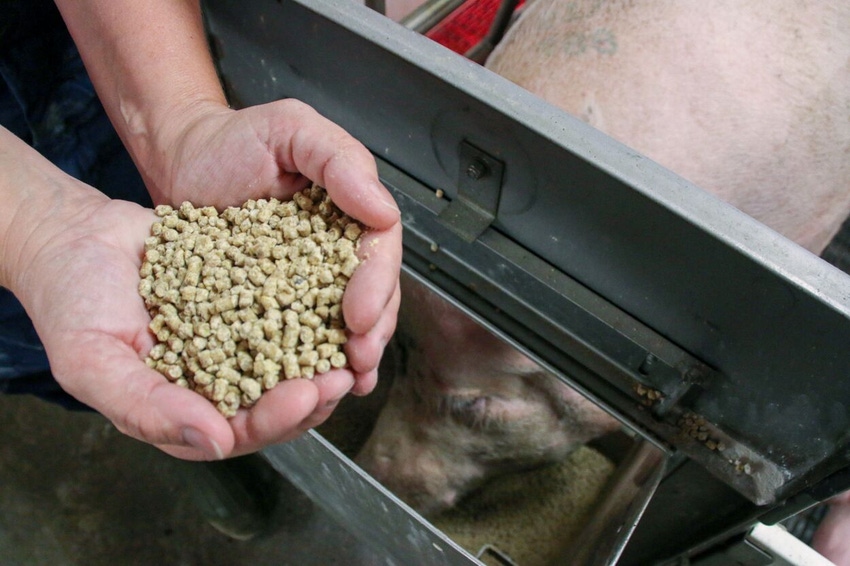Improvement in reproductive performance of sows may be achieved when sows consume additional levels of fiber as measured by total dietary fiber.
February 24, 2022

Traditionally, high fiber-containing feed ingredients have been utilized in diets for swine as means to decrease feeding costs. A review of 24 published reports suggests an increase in 0.2 to 0.6 pigs/litter (Reese et al., 2008). Therefore, there has been a traditional consensus that some levels of fiber are beneficial in diets for sows. However, it is still unknown at what level of dietary inclusion is fiber beneficial.
Part of the discrepancy may be the result that traditional analysis of dietary fiber (crude fiber and neutral detergent fiber) in feed ingredients may misestimate the level of fiber in the feed ingredients and the diets. The total dietary fiber (TDF; AOAC method 991.43) measures the concentration of fiber in the feed diets and feed ingredients more accurately than crude fiber or neutral detergent fiber (Urriola et al., 2019). Previous reviews of the impact of fiber on sow productive performance have used crude fiber or neutral detergent fiber. Most manuscripts published between 1998 and 2021 did not report the level of TDF in the test diets (Figure 1).
Therefore, we calculated the TDF intake of gestating sows from published papers to understand what level of TDF intake is beneficial to litter size (total born and born alive). A second objective was to compare the results when the TDF level of the diet was calculated using literature-based reference values vs. values derived from a current dataset.
The level of TDF content in carbohydrate-containing feed ingredients was collected from publications. When more than one publication containing the level of TDF in the test ingredient was found, the average was calculated. Values from the literature-based database were compared with values from AB-Vista.
The daily TDF intake of sows was calculated using the concentration of TDF in the test diets and the average daily feed intake of sows during gestation as reported by the publications. We observed that sows fed the treatment diets had indeed been consuming a greater concentration of TDF than sows fed the control diets (Figure 2). There were, however, significant differences in sow TDF intake among publications ranging between 200 and 850 g/d in sows fed in the control group and 400 and 1650 g/d in sows fed in the treatment group.
Interestingly, the total number of pigs born per litter increased (P < 0.05) when the TDF intake in the sows in the control group was increased between 100 and 500 g/d (R = 0.57; Figure 3). This effect was similarly observed when TDF intake was calculated with the current database. However, there was no effect of the feeding level of TDF on the number of pigs born among sows in the treatment group.
The effect of TDF intake on the reproductive performance of sows may be influenced by management practices such as record keeping definition of variables as well as other variables noticeable among experiments.
Therefore, the impact of TDF intake on the number of pigs born, born alive and the number of stillborn pigs was calculated as the average unweighted difference between the control group and the treatment group within each publication. As expected, sows in the treatment diets consumed on average more TDF (255 grams per day) than sows in the control group (Table 1).
This additional level of TDF intake ranged between 94 to 279 g/d. There was no effect of TDF intake on the total number of pigs born and born alive. Increasing the intake of TDF did decrease the number of stillborn pigs. It is worth noting that this review used a simple method for accounting for the effect of the experiment and biases induced in each publication. However, random factor models may be necessary to account for heterogeneity in response among publications.
In conclusion, an improvement in the reproductive performance of sows may be achieved when sows consume additional levels of fiber as measured by TDF. These effects may be realized with sows consuming a level between 100 and 250 grams of fiber per day. However, the results using a limited number of studies suggest that the effect is primarily a decrease in stillborn pigs. More importantly, the effects are variable and possibly dependent on the type of fiber-fed sows.
Source: Pedro Urriola and Venkata Sai Prasanth, who are solely responsible for the information provided, and wholly owns the information. Informa Business Media and all its subsidiaries are not responsible for any of the content contained in this information asset.
You May Also Like



